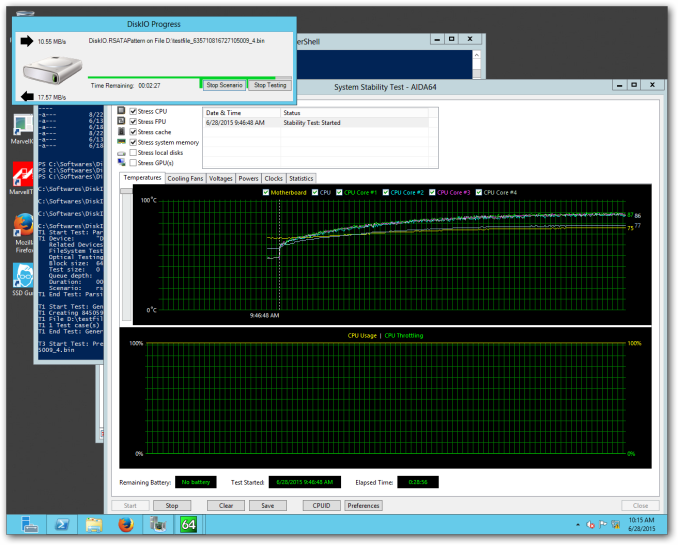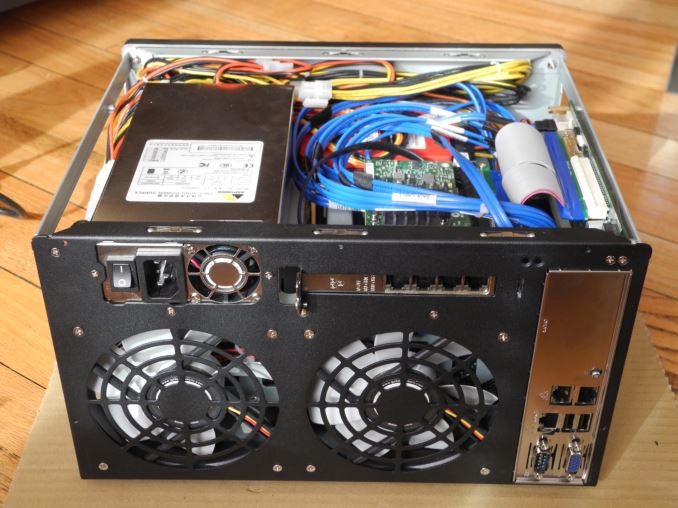ASRock Rack C2750D4I and U-NAS NSC-800: A DIY File Server
by Ganesh T S on August 10, 2015 8:45 AM EST- Posted in
- NAS
- storage server
- Avoton
- ASRock Rack
- U-NAS
Miscellaneous Aspects and Concluding Remarks
Low power consumption and the ability to keep the drives cool under stress are some of the desirable characteristics of file servers. In order to evaluate this aspect, we subject the system with Windows Storage Server 2012 R2 to a stability test using AIDA64. For stressing the disks (storage spaces volume using the drive bays), we used Microsoft's DiskIO with the pre-defined worst-case SATA patterns issued randomly with verification.
We find that the CPU doesn't throttle and the cores stabilize around 87 C, with the motherboard at 75 C. During this process, we also recorded power consumption at the wall. We found that the maximum power consumption was around 70 W, while the idling power consumption was around 38 W.
The ASRock Rack C2750D4I with the U-NAS NSC-800 is the first of three file servers that we have evaluated with Ubuntu 14.04 and Windows Storage Server 2012 R2. While the Phoronix Test Suite benchmarks have been chosen for their relevant to file server workloads, it appears that the SPEC SFS 2014 benchmarks do not bring out what people use the Storage Spaces feature for. We are still optimizing the testbed for SPEC SFS 2014, and we do have plans to evaluate other NAS OSes used in DIY builds using the same approach.
Coming to the business end of the review, we have two things to discuss. The ASRock Rack C2750D4I is almost the ideal motherboard for power users wanting to build a dedicated low-power file server or NAS. Native USB 3.0 support would have been nice, but a add-on card solution is not a bad one for those desiring high-speed external I/O. Other than that, there is not much to complain - The layout of the motherboard's SATA ports ensure that most of the disks can talk at full speed to the Avoton SoC. This becomes an issue only if one decides to take maximum advantage by utilizing all the SATA ports on the board. However, in our evaluation scenario, as the platform for a 8-bay file server, it fit in perfectly.
This brings us to the second aspect - the 8-bay U-NAS NSC-800. There are plenty of storage-focused chassis designs to choose from. In fact, the Silverstone DS380 is an excellent choice for those looking to install the motherboard in a flexible system. On the other hand, the NSC-800 brings in the compactness factor into the equation. Simply put, it is not possible to get a 8-bay NAS chassis smaller than the NSC-800. Any smaller, and a mini-ITX board with a single-slot PCIe card is not going to fit in. Even though U-NAS tries its best to make cabling easier by providing the SATA cables in a bundle from the backplane, installing the motherboard in such a cramped space is definitely a challenge.
The build presented in this review has a diskless cost of around USD 845 - a completely reasonable number given that the unit contains 8GB of ECC RAM. A look at the prices of commercial off-the-shelf diskless file servers based on Avoton make the DIY approach very attractive.












48 Comments
View All Comments
rrinker - Monday, August 10, 2015 - link
This chassis looks like just the thing to replace my WHS box. I was probably just going to run Server 2012 R2 Essentials and change over my StableBits DrivePool to the standard Server 2012 version. ALl these NAS boxes and storage system that everyone seems to go nuts over - none of them I've seen have the flexibility of the pooled storage that the original WHS, and WHS 2011 with DrivePool have had all along. Of course there are the Windows haters - but my WHS has been chugging along, backing up my other computers, storing my music and movies, playing movies through my media player, and the only time it's been rebooted since I moved to my new house a year and half ago was when the power went out. It just sits there and runs. One of the best products Microsoft came up with, so of course they killed it. Essentials is the closest thing to what WHS was. Replacing a standard mid tower case with something like this would save a bunch of space. 8 drives, plus a couple of SSDs for the OS drive.. just about perfect. I currently have 6 drives plus an OS drive in my WHS, so 8 would give me even more growing room. I have a mix of 1TB, 2TB, and 3TB drives in there now, with this, up to 8x 4TB which is a huge leap over what I have now.DanNeely - Monday, August 10, 2015 - link
At $400 for a (non-education) license, S2012 R2 Essentials is a lot more expensive than I want to go. If I build a new storage server on Windows I'm 99% sure I'll be starting with a standard copy of Win10 for the foundation.kmmatney - Monday, August 10, 2015 - link
The only thing missing from Windows 10 is the automated backup,which works great on WHS. That's the main thing holding me back from changing from WHS. I had to do a few unexpected bare-metal restores after installing Windows 10 on a few machines, and WHS really came through there. I had several issues restoring, but at the end of the day, it was successful in every instance.kmmatney - Monday, August 10, 2015 - link
I'm also a WHS 2011 + stablebit drivepool user. Best of everything - you can add or remove single drives easily, the data is portable and easy to extract if needed, you can choose what gets mirrored, and what doesn't. The initial balancing takes a while, but after that the speed is fine. I'm up to 8 drives now (7 in the drive pool), and can expand to 12 drives with my Corsair carbide case and a $20 SATA card. I keep an 80GB SSD out of the pool for running a few Minecraft servers. This DIY NAS is interesting, but it would be far cheaper for me to just replace some of my smaller drives with 4 TB models if I need more storage.Since WHS 2011 is Windows 7 based - it should still last a while - I don;t see a need to replace it anytime soon. But my upgrade path will probably be Windows 10 + Stablebit drive pool. Cheap and flexible.
DanNeely - Monday, August 10, 2015 - link
WHS 2011 is a pure consumer product (and based on a a server version of windows not win7); meaning it only has a 5 year supported life cycle. After April 2016, it's over and no more patches will be issued.Navvie - Tuesday, August 11, 2015 - link
I agree. Not being able to expand vdevs easily is a limitation. But weighing the pros and cons, it's a small price to pay.The last time I filled a vdev, I bought more drive and created an additional vdev.
BillyONeal - Monday, August 10, 2015 - link
If you want to pay the premium for hardware that can run Solaris nobody's stopping you.ZeDestructor - Monday, August 10, 2015 - link
ZFS is available on both FreeBSD and Linux, so it's no more expensive than boring old softraid on Linux.bsd228 - Friday, August 14, 2015 - link
What premium? I've run Solaris on many intel and amd motherboards, but most recently with the HP Microserver line (34L, 50L, 54L).digitalgriffin - Monday, August 10, 2015 - link
These are good articles. And for someone with a serious NAS requirement they are useful.But 99% of home users don't need a NAS
The 1% of us that do, only 1% need 8 bays with a $200 case and slow $400 intel board. That's a serious game system start up with at least 6 SATA connection motherboard.
For example Cooler Master HAF912 will hold over 8 drives and is $50.
6 SATA port motherboard 1150 socket mb $120.
3.2GHz i-3 (low power processor Y or T version for $130)
PCIe SATA card $50.
Lets see you build a build a budget system that can:
Handle 5 drives (boot/cache, Raid 6 (two drives + 2 parity))
Handle transcoding with Plex server.